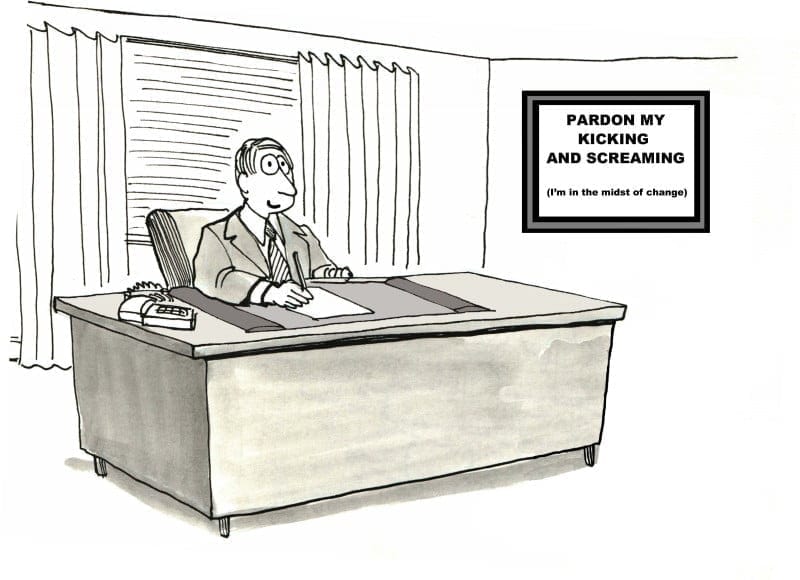Whenever a change is introduced into the organization there will inevitably be resistance to it. Whether it is a change to an ITSM process, a change in supporting technology, or a service improvement initiative, it will impact people and therefore resistance to change will occur. Every person is different and will react to change in a different way.
Table of Contents
ToggleWHY PEOPLE RESIST CHANGE
The biggest reason people resist change is fear of the unknown. People will only move towards a future state when they believe, or more importantly ‘feel’ that the risk of staying in the current state is greater than the risk of moving to the future state.
There could be historical reasons for resistance to change. If past change initiatives were poorly managed or failed, there could be a lack of trust that this current improvement can be effectively implemented.
People may not have a clear picture of what the change looks like and why it is being undertaken. If there is a lot of change happening in the organization, employees may be experiencing change fatigue and therefore resist additional change.
We often ‘blame’ the resisters to change as the problem for the change failing. However, I would argue that resistance to change could be a good thing.
RESISTANCE TO CHANGE – A GOOD THING?
Firstly, if people are resisting change it means that people have actually started on their change journey. They are no longer in denial that a change is happening but have recognised that they are going to need to change and adopt a new way of working. If people are in denial, that is a bad thing. If they are resisting the change, that is a good thing!
There are two types of resistance – covert and overt. Covert resistance is the grumbling around the water cooler or use of diversionary tactics at meetings to discuss the change. Covert resistance is unproductive but it could be a result of employees not feeling safe raising what could be a legitimate concern in planning meetings. This situation needs to be addressed as soon as possible.
Overt resistance is where employees openly challenge a change as a mistake or point out downfalls. Overt resistance is not necessarily a bad thing. Employees may actually be right in their objections to the change. They may recognize issues that their management have not anticipated. They are often ‘closer to the action’ and have insights that their management team do not have. Overt resistance should be encouraged and employees provided with the channels to fully communicate the issues they perceive.
Listening to, and addressing the issues raised by overt resistors can often make them the greatest advocates and champions for your change initiative. Getting them actively involved with the change can be the key to success.
Recognise that substantial resistance to a change may in fact mean that the change is not a good idea and should be stopped to avoid a disastrous failure!
BE THANKFUL
When resistance to change occurs, we should be thankful, as this will drive us to do a number of things.
If resistance to change is because the change is not understood then we need to address the question ‘Why is the change necessary?’. In the words of John Kotter, we need to ‘create a sense of urgency’. We need to increase and/or improve our communications and develop a compelling business case. We need to address the ‘what’s in it for me?’ question and therefore ensure that we fully understand how the change will impact people.
If resistance to change is a result of change fatigue this may force us to slow down and prioritise the changes taking place in the workplace.
Resistance to change forces us to listen and gather feedback. It forces us to get employees involved with the change and foster better solutions.
It forces us to develop resistance management and reinforcement plans. We need to identify the techniques we will adopt to overcome the resistance to the change and when we get people to adopt a new way of working how do we reinforce it so that people don’t revert to the old ways of working.
SUMMARY
Resistance to change is a normal response. But resistance to change is less of a problem than employees ignoring the change or being in denial of the change.
So anticipate the resistance that your change may encounter and embrace it. It’s a good thing!
FAQ
A: People may resist change due to fear of the unknown, loss of familiarity, potential disruption to routines, uncertainty about their roles, or a perceived lack of control or involvement in the change process.
A: Yes, resistance to change can be beneficial as it encourages critical thinking, sparks innovation and alternative solutions, ensures thorough evaluation of the change, and helps identify potential risks or unintended consequences.
A: Organizations can manage resistance to change by fostering open communication, providing clear rationale and benefits of the change, involving employees in the decision-making process, addressing concerns and providing support, and creating a culture that values learning and adaptation.
A: Embracing resistance to change can lead to improved change implementation, enhanced employee engagement and buy-in, better decision-making through diverse perspectives, increased creativity and problem-solving, and ultimately, successful and sustainable change initiatives.
A: Individuals can overcome their resistance to change by seeking understanding and knowledge about the change, reframing their perspective to focus on potential benefits, staying open to new possibilities, seeking support from others, and taking proactive steps to adapt and grow in the face of change.





